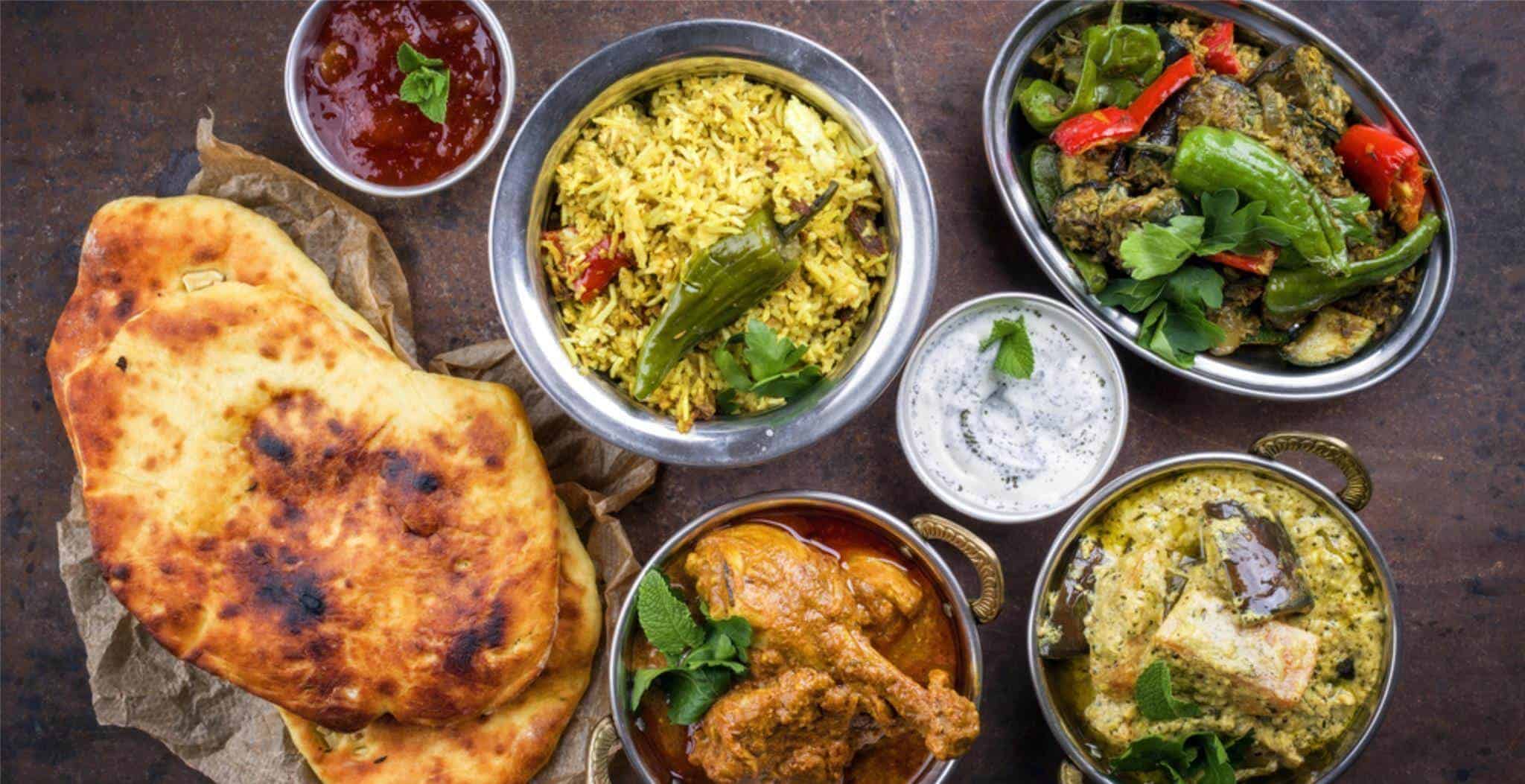
The British Curry
by Debabrata Mukherjee
The UK now celebrates National Curry Week every October. Although curry is an Indian dish modified for British tastes, it’s so popular that it contributes more than £5bn to the British economy. Hence it was hardly surprising when in 2001, Britain’s foreign secretary Robin Cook referred to Chicken Tikka Masala as a “true British national dish”.
If Britain taught India how to play cricket, India perhaps returned the favour by teaching the British how to enjoy a hot Indian curry. By the 18th century, East India Company men (popularly called ‘nabobs’, an English corruption of the Indian word ‘nawab’ meaning governors or viceroys) returning home wanted to recreate a slice of their time spent in India. Those who couldn’t afford to bring back their Indian cooks satisfied their appetite at coffee houses. As early as 1733, curry was served in the Norris Street Coffee House in Haymarket. By 1784, curry and rice had become specialties in some popular restaurants in the area around London’s Piccadilly.
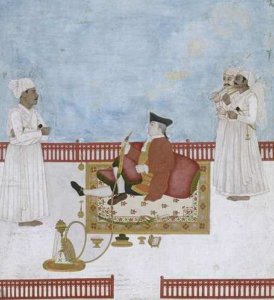 An East India company official enjoying hookah (in India)
An East India company official enjoying hookah (in India)The first British cookery book containing an Indian recipe was ‘The Art of Cookery Made Plain & Easy’ by Hannah Glasse. The first edition, published in 1747, had three recipes of Indian pilau. Later editions included recipes for fowl or rabbit curry and Indian pickle.
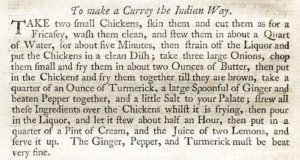 Excerpt from ‘The Art of Cookery Made Plain and Simple’ by Hannah Glasse
Excerpt from ‘The Art of Cookery Made Plain and Simple’ by Hannah GlasseThe first purely Indian restaurant was the Hindoostanee Coffee House which opened in 1810 at 34 George Street near Portman Square, Mayfair. The owner of the restaurant, Sake Dean Mahomed was a fascinating character. Born in 1759 in present-day Patna, then part of the Bengal Presidency, Mahomed served in the army of the East India Company as a trainee surgeon. He later travelled to Britain with ‘his best friend’ Captain Godfrey Evan Baker and even married an Irishwoman. With his coffee house, Mohamed tried to provide both authentic ambience and Indian cuisine “at the highest perfection”. Guests could sit in custom-made bamboo-cane chairs surrounded by paintings of Indian scenes and enjoy dishes “allowed by the greatest epicures to be unequalled to any curries ever made in England”. There was also a separate smoking room for hookahs.
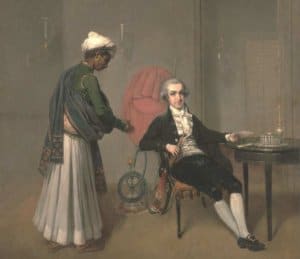 ‘Portrait of a Gentleman, Possibly William Hickey, and an Indian Servant’ by Arthur William Devis, 1785
‘Portrait of a Gentleman, Possibly William Hickey, and an Indian Servant’ by Arthur William Devis, 1785One of the chief patrons of the restaurant was Charles Stuart, famously known as ‘Hindoo Stuart’ for his fascination with India and the Hindu culture. However, unfortunately, the venture was unsuccessful and within two years Dean Mohamed filed for bankruptcy. It was difficult to compete with other curry houses that were better established and were closer to London. Also, it is likely that nabobs in the Portman Square locality could afford to employ Indian cooks, hence not much need to go out to try Indian dishes.
Lizzie Collingham in her book ‘Curry: A Tale of Cooks & Conquerors’ argues that Britain’s love for curry was fuelled by the bland nature of British cookery. The hot Indian curry was a welcome change. In William Thackeray’s satirical novel ‘Vanity Fair’, the protagonist Rebecca’s (also known as Becky Sharp) response to cayenne pepper and chili shows how unfamiliar Britons were to spicy food:“Give Miss Sharp some curry, my dear,” said Mr. Sedley, laughing. Rebecca had never tasted the dish before……..“Oh, excellent!” said Rebecca, who was suffering tortures with the cayenne pepper. “Try a chili with it, Miss Sharp,” said Joseph, really interested. “A chili,” said Rebecca, gasping. “Oh yes!” She thought a chili was something cool, as its name imported……. “How fresh and green they look,” she said, and put one into her mouth. It was hotter than the curry……….. “Water, for Heaven’s sake, water!” she cried.
By the 1840s sellers of Indian products were trying to persuade the British public with the dietary benefits of curry. According to them, curry aided digestion while stimulating the stomach thereby invigorating blood circulation resulting in a more vigorous mind. Curry also gained popularity as an excellent way of using up cold meat. In fact currying cold meat is the origin of jalfrezi, now a popular dish in Britain. Between 1820 and 1840, the import of turmeric, the primary ingredient in making curry, in Britain increased three fold.
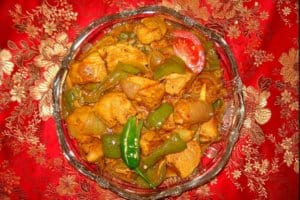 Chicken Jalfrezi
Chicken JalfreziHowever, the bloody revolt of 1857 changed the British attitude towards India. Englishmen were banned from wearing Indian clothes; recently educated public officials disparaged old company men who had gone native. Curry too ‘lost caste’ and became less popular in fashionable tables but was still served in army mess halls, clubs and in the homes of common civilians, mainly during lunch.
Curry needed a jolt and who better to promote it than the Queen herself. Queen Victoria was particularly fascinated by India. Her interest in India could be seen at the Osborne House, which she and her husband Prince Albert built between 1845 and 1851. Here she collected Indian furnishings, paintings, and objects in a specially designed wing. The Durbar Room (initially commissioned to be built as a sumptuous Indian dining room in 1890 by the Queen) was decorated with white and gold plasterwork in the shapes of flowers and peacocks.Victoria employed Indian servants. One among them, a 24-year-old named Abdul Karim, known as the Munshi, became her ‘closest friend’. According to Victoria’s biographer A.N. Wilson, Karim impressed the monarch with chicken curry with dal and pilau. Later her grandson George V was said to have little interest in any food except curry and Bombay duck.
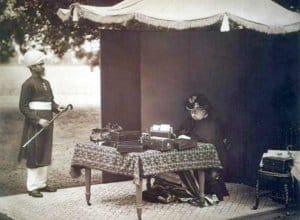 Queen Victoria and the Munshi in 1893
Queen Victoria and the Munshi in 1893By the early 20th century, Britain had become home to around 70,000 South Asians, mainly servants, students and ex-seamen. A handful of Indian restaurants sprang up in London, the most famous being Salut-e-Hind in Holborn and the Shafi in Gerrard Street. In 1926, Veeraswamy opened at 99 Regent Street, the first high-end Indian restaurant in the capital. Its founder Edward Palmer belonged to the same Palmer family frequently mentioned in William Dalrymple’s famous book, ‘The White Mughals’. Edward’s great-grandfather William Palmer was a General in the East India Company and was married to Begum Fyze Baksh, a Mughal princess. Palmer’s restaurant was successful in capturing the ambience of the Raj; notable clients included the Prince of Wales (later Edward VIII), Winston Churchill and Charlie Chaplin, amongst others.
Curry was yet to establish itself firmly in British cuisine. In the 1940s and 1950s, most major Indian restaurants in London employed ex-seamen from Bangladesh, particularly from Syhlet. Many of these seamen aspired to open a restaurant of their own. After the Second World War, they bought bombed-out chippies and cafes selling curry and rice alongside fish, pies, and chips. They stayed open after 11 pm to catch the after-pub trade. Eating hot curry after a night out in the pub became a tradition. As customers became increasingly fond of curry, these restaurants discarded British dishes and turned into inexpensive Indian takeaways and eateries.
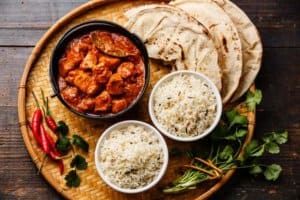 Chicken Tikka Masala, Britain’s favorite curry
Chicken Tikka Masala, Britain’s favorite curryAfter 1971, there was an influx of Bangladeshi immigrants into Britain. Many entered the catering business. According to Peter Groves, co-founder of National Curry Week, “65%-75% of Indian restaurants” in the UK are owned by Bangladeshi immigrants.
Today there are more Indian restaurants in Greater London than in Delhi and Mumbai combined. As Robin Cook aptly puts it, this national popularity of curry is a “perfect illustration of the way Britain absorbs and adapts external influences”.
By Debabrata Mukherjee. I am an MBA graduate from the prestigious
Indian Institute of Management (IIM), currently working as a consultant
for Cognizant Business Consulting. Bored with mundane corporate life, I
have resorted to my first love, History. Through my writing, I want to
make history fun and enjoyable to others as well.
=============================================
Britain came to kerala for spice trade
there is a story [true or not i dont know]how they learned the name of each item in 1600's
the british sailors went to the road side market and asked for names of each item
cashewnut was being sold at 8 pieces for one cash
in malayalam language 8 pieces for one cash is kasinu ettu=means for one cash; ettu means eight pieces
the english soldiers started calling it cashewnut(kasinu ettu/one cash eight pieces )
==========================================
another story -dont know true or not :-
they asked name of jack fruit -(1600'S)
in malayalam language it is called CHAKKA
SO it became JACK[CHAKKA ANGLICANISED]=jack fruit
SIMILARLY MANY STORIES -THE PRESENT GENERATION MAY NOT KNOW
-----------------------------------------------------------------------------------------------------------------
CURRY
IT WAS ONLY IN MALAYALM (AS FAR AS I KNOW)CURRY WAS USED-1600'S
=============================================
THE NEXT STATE CALLED MADRAS {NOW TAMILNADU} CALL IT THANNI
FOR MULAGU THANNI=MEANS CHILLI/MASALA WITH WATER
MULAGU THANNI WAS ANGLICANISED BY THE ENGLISH MAN TO MULAIGU TANNI
THEY [MADRAS]ALSO CALL WATERY MASLA AS CHAARU=PRONOUNCED SAARU
Kuzhambu - Wikipedia
-----------------------------------------------------------------------
ENGLISH MAN DIDNOT COME IN CONTACT WITH PEOPLE OF MYSORE STATE EXCEPT AFTER DEFEAT OF TIPPU SULTAN IN 1800
SO THEY DID NOT PICK UP WORDS FROM KANNADA LANGUAGE -TO MY KNOWLEDGE
===========================================
similarly telugu people were under nizam of hyderabad and in north under marathas -so english language did not get any word from telugu-AS FAR AS I KNOW
===========================================
so curry originated in kerala /malayalam language



